Matador Network's Blog, page 118
September 23, 2024
A New Four Seasons Trip Around the World Is Wildly Luxurious (and Wildly Expensive)

If you don’t yet have plans for September of 2026 — and have an extra $229,000 laying around — you may want to consider booking your seat on the newly announced “Grand Horizons, A Cross-Continental Voyage,” hosted by Four Seasons.
The high-end group trip visits nine destinations around the world, staying in luxury Four Seasons hotels along the way. The trip starts in late August of 2026 in Napa Valley, California. From there, guests will travel via the 48-person Four Seasons Private Jet to Tokyo, Japan; Ha Long Bay, Vietnam; Bangkok, Thailand; Istanbul, Türkiye; Milan, Italy; Mallorca, Spain; Lisbon, Portugal; and Montreal, Canada. The total cost of the trip is $229,000 per person, breaking down to $9,541 per day. That’s based on double occupancy; single travelers will need to pay an extra $22,900 supplement. There’s also an upcharge for visitors who would like to spend two days in Thailand’s Koh Samui, rather than Bangkok.
View this post on Instagram
A post shared by Four Seasons Hotels | Resorts (@fourseasons)
While the steep price tag may rule out your average 30-something traveler, it does cover nearly all expenses travelers will incur. That includes flights between destinations on a private jet, all accommodations, all meals and drinks, daily sightseeing and destinations activities, all gratuities, and a travel planner to coordinate all the details. Travelers on the Four Seasons trip around the world will also be accompanied by a physician (perhaps indicating that they expect deep-pocketed travelers to skew a little older) and have a luggage concierge at every property. They’ll also get “private access and exclusive experiences you can only get through Four Seasons.”
Guests on the Grand Horizons trip will stay at hotels including the Four Seasons Hotel Istanbul at Sultanahmet, a former prison built in 1919 that the brand turned into a five-star hotel in the city’s historic district. Other lodgings will include the Four Seasons Resort Mallorca at Formentor, (newly opened in August of 2024), as well as two nights on a luxury chartered ship on Vietnam’s stunning Ha Long Bay. And when it comes to activities, guests will have their choice of what to do in each destination. “Choose from our carefully curated selection of activities, make private arrangements, or simply relax and enjoy our luxurious Four Seasons properties. In each destination, our Onboard Concierge will customize every experience for you, even if it’s off-program or last-minute,” writes the trip-booking website. Each traveler will have access to a “Guest Services Manager” to start planning activities approximately five months before departure. Unfortunately, there’s no choosing your seat: they’ll be assigned by the trip planners.

Photo: Four Seasons Private Jet Experiences
Guests will be aboard the company’s private jet when moving between countries, custom built for Four Seasons luxury trips. Seats are configured in a two-by-two layout and convert into lay-flat beds. The crew-to-guest is one-to-six, and the amenity kits are a tier above even the most expensive commercial airline. Guests will receive a leather tote bag with items like Four Season slippers, an in-flight convenience kit, and Bose noise-cancelling headphones, among other items. There’s also a lounge area and bar, as well as a full kitchen on board, allowing in-flight Four Seasons chefs to serve meals, snacks, and drinks, each inspired by the destination to come.

The lounge area on the Four Seasons Private Jet. Photo: Four Seasons Private Jet Experiences
The Four Seasons brand launched its private jet journeys in 2015, but the new Grand Horizons Four Seasons trip around the world is the most expensive offering to date. Nearly all Four Seasons trips via private jet start around $150,000 per person, with the next most expensive trip costing $224,000 per person for a 22-day trip. That journey, called “Timeless Encounters,” visits destinations like Sydney, Australia; Chang Mai, Thailand; Bali, Indonesia; and Prague, Czech Republic, among others. The 2025 trip is sold out, but 2026 is still available.
If $224,000 or $229,000 per person sounds too pricey, you can save $81,000 per person by booking the 13-day “African Wonders” trip, priced at $148,000 per person. 
Where to Play, Eat, and Stay in Cobb County, Atlanta’s Suburban Neighbor

Atlanta’s neighbor in the greater metropolitan area, Cobb County is a sweet spot for travelers: you get the Southern charm of suburban Georgia while being a half-hour away from a major city. With attractions like Truist Park, home of the Atlanta Braves, and Six Flags, Cobb County is a particularly great place for family vacations. But there’s a little something for everyone, from historical sites and outdoor spaces to great restaurants and breweries. These are some of the best things to do in Cobb County, plus where to eat, drink, and stay.
Things to do in Cobb CountyGo to an Atlanta Braves game
Photo: Mr. Lando/Shutterstock
About 10 miles outside of downtown Atlanta, in Cobb County’s Cumberland, Truist Park is the proud home of the Atlanta Braves. If you’re in town during baseball season, you’ll appreciate the 41,000-seat ballpark’s timeless charm, modern amenities, and wide array of concessions. It’s worth a visit in the off-season, too, thanks to year-round Truist Park Tours.
Truist Park: 755 Battery Ave SE, Atlanta, GA 30339
Check out The Battery
Photo: WorldTraveler_1/Shutterstock
Before or after taking in a Braves game, head to The Battery, located right next to Truist Park, where you’ll find 22 bars and restaurants. Walk the plaza with a cold one or grab a bite at PH’EAST, a food hall that was inspired by Asia’s hawker markets. There are a variety of Asian street food vendors, including Lifting Noodles Ramen, 26 Thai, Fan T’Asia, and Poke Burri. You can eat indoors or on the 1,500-square-foot covered patio. You can also stay right by the action at The Battery’s Omni Hotel. The hotel has its own drinking and dining venues, including the National Anthem restaurant and the 582 Waterside Lounge & Bar.
The Battery: 800 Battery Ave SE, Atlanta, GA 30339
Wander around Vinings JubileeView this post on Instagram
A post shared by Vinings Jubilee (@viningsjubilee)
Vinings Jubilee is an outdoor mall in Vinings that houses a community of Cobb County merchants. It’s the perfect setting for a family outing, a good meal, or a shopping spree. I had a great cup of coffee at Read Shop by the Merchant while pursuing its book selection, then enjoyed the sunshine as I walked by restaurants like SOHO and Stockyard Burgers & Bones and workout studios like Pure Barre and Orangetheory Fitness.
The Vinings Jubilee Farmers Market is a weekly event that takes place every Thursday throughout the year. Over 20 farmers and vendors come together to showcase their fresh produce and goods along New Paces Ferry Road from 2 PM to 5 PM.
Vinings Jubilee: 4300 Paces Ferry Rd SE, Atlanta, GA 30339
Float down the Chattahoochee River
Photo: BluIz70/Shutterstock
Locals call floating down the Chattahoochee River time to “Shoot the Hooch.” You can float down the river via tube, canoe, raft, kayak, or stand-up paddleboard, whether you bring your own or rent them from Powers Island in the Chattahoochee River National Recreation Area.
Seek thrills at Six Flags Over GeorgiaView this post on Instagram
A post shared by Six Flags Over Georgia (@sixflagsovergeorgia)
At Six Flags Over Georgia, test your bravery on 10 roller coasters, including the Cliffhanger, the Tornado, and the impressive 20-story Goliath hypercoaster. If you come with kids, check out children’s areas like Bugs Bunny World, Whistlestop Park, and Carousel Hill. Hurricane Harbor Water Park has wave pools, slides, and more, but if you want the full water park experience, there’s also a private water park called Six Flags White Water.
Six Flags Over Georgia: 275 Riverside Pkwy, Austell, GA 30168
Shop local at Marietta Square
Photo: BluIz70/Shutterstock
In Marietta, there’s a wide range of local shopping, museums and a local theater, and outdoor parks that offer a deep dive into the city’s cultural heritage. You’ll also find a varied food scene and lively nightlife, including informative brewery tours where you can learn about the craft of beer-making. While in Marietta, be sure to visit Glover Park to make a wish at the fountain.
Marietta Square: 99 S Park Square NE, Marietta, GA 30060
Where to eat and drink in Cobb CountyHamp & Harry’sView this post on Instagram
A post shared by Hamp & Harry’s (@hampandharrys)
Located on Marietta Square, Hamp and Harry’s is part intimate cocktail den, part neighborhood joint, with a food menu that constantly changes to showcase the produce and dedication of local farmers and small businesses. I had the brunch burger with Angus beef, maple-glazed bacon, a sunny-side-up egg, and the signature paprika aioli.
Hamp & Harry’s: 168 Roswell St NE, Marietta, GA 30060
Muss & Turner’sView this post on Instagram
A post shared by Muss & Turner’s (@mussandturners)
This bistro in Vinings serves innovative sandwiches during the day (such as The Gobbler, with turkey, Ritz cracker stuffing, lingonberry puree, and thyme aioli) and New Southern cuisine at night. You can also stop by for brunch or order off the Afternoon Delights menu between 3 PM and 5 PM for a truncated list of options with some discounted prices.
Muss & Turner’s: 1675 Cumberland Pkwy SE Suite 309, Cumberland, GA 30080
Eleanor’sView this post on Instagram
A post shared by Muss & Turner’s (@mussandturners)
Eleanor’s is hidden behind a secret freezer door at the back of Muss & Turner’s. Named after Eleanor Seale, a former New Yorker who became part of the success behind Muss & Turner’s, the speakeasy is the perfect place for a dinner-and-drinks date night or a lunch rendezvous.
Eleanor’s: 1675 Cumberland Pkwy SE Suite 309, Cumberland, GA 30080
Where to stay in Cobb CountyCourtyard Atlanta Vinings/GalleriaA stay at the Courtyard Atlanta Vinings/Galleria promises easy access to a lot of Cobb County attractions, including Truist Park. My room was outfitted with all of the essentials, from complimentary WiFi to a mini-fridge and microwave. When you’re not snacking in-room, the hotel has an on-site restaurant and bar called the Bistro, which serves classic American fare, Starbucks drinks, and cocktails. I enjoyed taking my morning coffee out to the outdoor terrace and relaxing by the indoor pool at night. For those that need to plan their daily routines around getting some exercise, the fitness center is open 24 hours a day.
Courtyard Atlanta Vinings/Galleria: 2829 Overlook Pkwy, Atlanta, GA 30339
Sonesta Select Atlanta Cumberland GalleriaThe Sonesta Select Atlanta Cumberland Galleria is a great choice for baseball fans. A stone’s throw from Atlanta Braves home games, the hotel is also a short drive from Six Flags White Water, the Galleria Mall, and Coca-Cola Roxy music venue in The Battery, making it a great choice for leisure travelers looking for local entertainment options. From Hartsfield-Jackson Atlanta International Airport (ATL), it’s roughly 25 minutes by car.
Sonesta Select Atlanta Cumberland Galleria Ballpark: 3000 Cumberland Blvd SE, Atlanta, GA 30339
How to get to Cobb County
Photo: Billy F Blume Jr/Shutterstock
Cobb County is located within driving distance of several popular cities for a weekend trip, including Savannah, Athens, and Augusta, GA; Charlotte, NC; Charleston, SC; and Jacksonville and Tallahassee, FL. If you’re flying to Cobb County, the closest airport is ATL, which offers connections to more than 150 US cities and dozens of international destinations. From there, you can take an Uber or drive about 25 minutes to Cobb County.
But remember: ATL is one of the busiest airports in the world, so make sure you give yourself extra time to get in and out on travel days.
How to get around Cobb County
Photo: Billy F Blume Jr/Shutterstock
While many people who visit Cobb County come by car or rent one when they arrive, you can easily reach Atlanta by public transportation or ride share. Downtown and Midtown are about 20 minutes away by car. The Metropolitan Atlanta Rapid Transit Authority (MARTA) also runs throughout Atlanta as well as suburbs, including stops like the Cumberland Mall in Cobb County. Another option to get around by bus is CobbLinc, which operates along key routes in Cobb County, with multiple services connecting to MARTA bus stops and rail stations. 
Get Ready to “WOW” Your Travel Partners With These Epic Iceland Airbnbs

According to Airbnb, there has been a 130 percent increase in stays at Airbnbs with Northern Lights views. The best Airbnbs in Iceland offer front row seats to the northern lights — making it the top place to go to see them. Not only that, but by booking a remote stay you’ll have easy access to the outdoor adventures this Nordic country is known for. The best Iceland Airbnbs even offer extras — like hot tubs, fireplaces, maybe even a chance to greet a gaggle of wild horses as they traverse their way across the countryside. “Wow” your travel partners with these epic Iceland Airbnbs.
Traveling to Iceland? Check out Matador’s Iceland accommodations guides: These Iceland Airbnb rentals make for the perfect Iceland basecamp Jaw-dropping Iceland Airbnbs for a bucket list summer vacation 3 Airbnbs in Selfoss, Iceland where you can see the Northern Lights This lakeview retreat Airbnb is the ideal way to experience’s Iceland’s natural beauty Watch the Northern Light’s from this Iceland Airbnb’s geothermal hot tub
We hope you love the Iceland Airbnb properties we recommend! Just so you know, Matador may collect a small commission from the links on this page if you decide to book a stay. Listed prices are accurate as of the time of publication.
Glass cottage with hot tub under the northern lights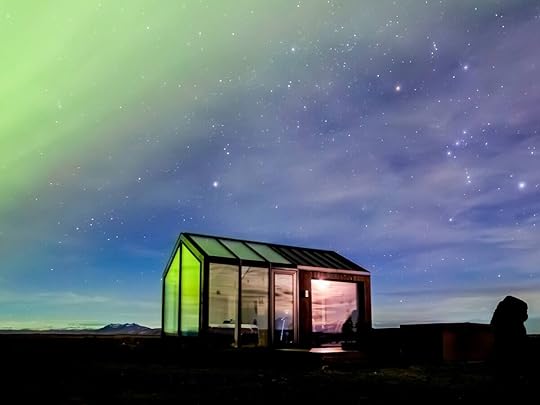 Photo: Airbnb
Photo: Airbnb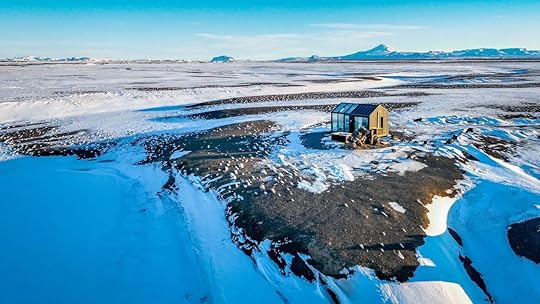 Photo: Airbnb
Photo: Airbnb Photo: Airbnb
Photo: Airbnb Photo: Airbnb
Photo: AirbnbSee more photos
This glass cottage Airbnb is exactly what you came to Iceland for. Gaze up at the sky as the northern lights pass overhead, swirling colors that reflect in infinite beauty off this glass-encased home. Although this spot is just southeast of Reykjavik, you’ll feel as though you’re on another planet. Enjoy the private hot tub and the charm of being “out there” with the opportunity in the nearby town of Hella for swimming, sauna, waterslides, and services. And if you plan to visit Landmannalaugar while in Iceland, this is the prime basecamp to start and end your journey.
Two guests, one bedroom
Price: $594 per night
 Photo: Airbnb
Photo: Airbnb Photo: Airbnb
Photo: Airbnb Photo: Airbnb
Photo: Airbnb Photo: Airbnb
Photo: AirbnbSee more photos
Stay in one of several rooms available in this well-trimmed cottage. Views extend to the high country and the property has an incredible balcony patio overlooking the surrounding landscape. The Glacier lagoon and all of the South coast of Iceland is within easy reach. En-suite, you’ll have a private bathroom and rain shower and a slice of the heavenly views all to yourself.
Two guests, one bedroom
Price: $230 per night
 Photo: Airbnb
Photo: Airbnb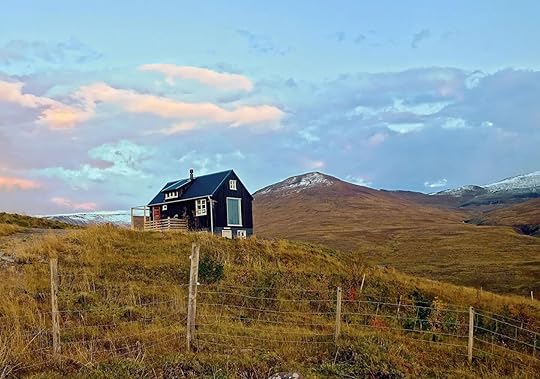 Photo: Airbnb
Photo: Airbnb Photo: Airbnb
Photo: Airbnb Photo: Airbnb
Photo: AirbnbSee more photos
You know a place is awesome when its location tag lists “the next town is Búðardalur”. No one will be around to bother you as you gaze upward at the Northern Lights from this Iceland Airbnb. It’s located on a hilltop in western Iceland, the perfect place to head if you hope to experience all of Iceland’s natural splendor. A free natural pool open 24 hours is 20 minutes up the road. In the village 15 minutes away you can wine, dine, and stock up on supplies for your epic night of stargazing.
Four guests, one bedroom
Price: $250 per night
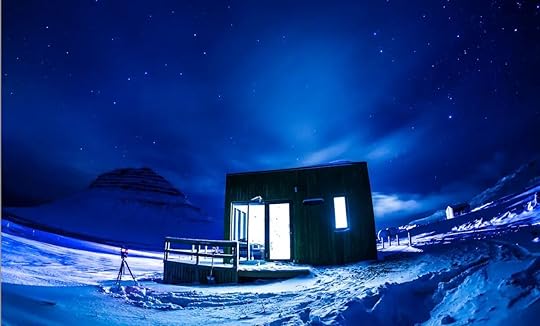 Photo: Airbnb
Photo: Airbnb Photo: Airbnb
Photo: Airbnb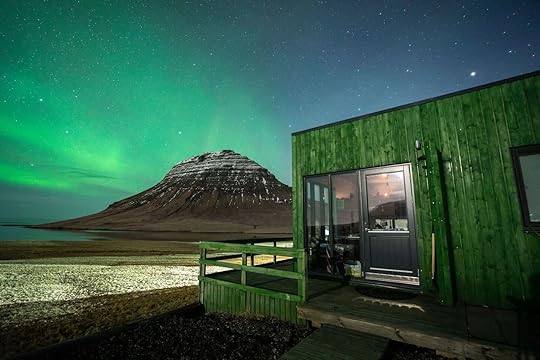 Photo: Airbnb
Photo: Airbnb Photo: Airbnb
Photo: AirbnbSee more photos
Iceland farm stays are among the best ways to get remote and experience both the Northern Lights and the rugged terrain of Iceland. At this property, you’ll have privacy and views, with easy access to nature. Nearby are black sand beaches and lava fields, plenty of hiking, and the most incredible sunrise and sunset views you’ve ever seen. The home is warm and comfortable, and we highly recommend an evening of gazing at the stars.
Two guests, one bedroom
Price: $140 per night
 Photo: Airbnb
Photo: Airbnb Photo: Airbnb
Photo: Airbnb Photo: Airbnb
Photo: Airbnb Photo: Airbnb
Photo: AirbnbSee more photos
Soaking in a natural hot spring after a day of adventure is something nearly all travelers enjoy, and even pursue. But relaxation is a lot less soothing when there are half a dozen other people in a tiny hot spring pool with you. This luxurious lodge solves that problem. You’ll have your own private hot spring in which to chill as the northern lights (hopefully) pass overhead. And the lodge itself is noteworthy, too — a well-furnished artist’s haven with a private deck and lake views. The lodge is part of the gated Hvammsvik Estate, among the most desirable places to stay in all of Iceland.
Six guests, three bedrooms
Price: $748 per night
 Photo: Airbnb
Photo: Airbnb Photo: Airbnb
Photo: Airbnb Photo: Airbnb
Photo: Airbnb Photo: Airbnb
Photo: AirbnbSee more photos
There’s something so romantic about staying in a geodesic dome with a fireplace — even if you’re on a solo excursion. Add in the hot tub and you have one of the most relaxing and intriguing Airbnbs in Iceland. On the outskirts of Reykjavik, you’re both close to the amenities of the city and perfectly removed from its vibrations. The water is right here, and should you feel up for a foot-powered natural excursion, as much as you can handle is right outside your door.
Two guests, one bedroom
Price: $518 per night
 Photo: Airbnb
Photo: Airbnb Photo: Airbnb
Photo: Airbnb Photo: Airbnb
Photo: Airbnb Photo: Airbnb
Photo: AirbnbSee more photos
Track lighting has never before held such an important role in an Iceland Airbnb. The living room and bedroom walls in this high-end downtown Reykjavik Airbnb apartment are lined with art. Said art is illuminated by the track lights, turning your stay into a private art show in the heart of the city. The property is accessed via elevator from street level and offers views out over downtown. You’ll have access to two private parking spots underneath the building, should you need them, but this place is so close to the city’s dining and nightlife that walking is the best way to get around.
Eight guests, four bedrooms
Price: $819 per night
 Photo: Airbnb
Photo: Airbnb Photo: Airbnb
Photo: Airbnb Photo: Airbnb
Photo: Airbnb Photo: Airbnb
Photo: AirbnbSee more photos
What do you think of when you think of Iceland? Beyond the Blue Lagoon, a few things likely come to mind: mountains, glaciers, rivers, and the ocean. Oh, and horses, too. You’ll have a front-row seat to all of the above at this high-heeled but remote Airbnb near Iceland’s southern coast. Within a quick drive are multiple national parks, waterfalls, and other bodies of water. With so much to see, there’s no better place to plant yourself for an all-encompassing Iceland tour.
Four guests, one bedroom
Price: $124 per night
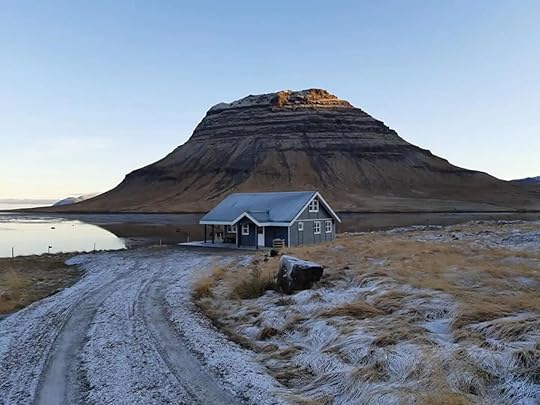 Photo: Airbnb
Photo: Airbnb Photo: Airbnb
Photo: Airbnb Photo: Airbnb
Photo: Airbnb Photo: Airbnb
Photo: AirbnbSee more photos
It’s hard to say you’ve seen Iceland until you’ve experienced its water caves and lava fields. From this gorgeous home at the foot of one of Iceland’s most stunning hills, you can kayak pristine waters and easily access many of the country’s iconic natural highlights. Out on the peninsula near the famed Snæfellsjökull National Park, this is the best Airbnb in Iceland for exploring the western coast. You could spend a lifetime exploring the jagged coastline here, and we wouldn’t blame you if you never returned home.
Eight guests, three bedrooms
Price: $252 per night
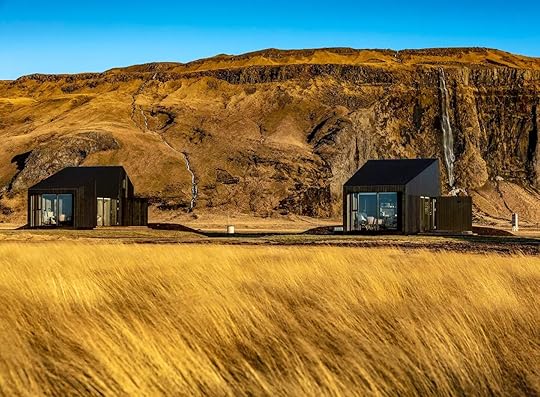 Photo: Airbnb
Photo: Airbnb Photo: Airbnb
Photo: Airbnb Photo: Airbnb
Photo: Airbnb Photo: Airbnb
Photo: AirbnbSee more photos
No Airbnb in Iceland better captures the country’s rugged remoteness than this magical stay. Two tiny houses with private porches and epically expansive views sit near the base of the Seljalandsfoss Waterfall. The northern lights regularly dance above the home, and you can watch in comfort as the property is modern, warm, and trimmed to accommodate. This is the perfect romantic couples’ retreat, where you can dine by candlelight while keeping an eye out for horses passing by out front.

Four guests, two bedrooms
Price: $275 per night
Richmond’s Historic Waterfront Is Going Strong. Here’s How to Get In on the Action on a Trip to BC.

On a floating restaurant patio in Steveston Village, an enclave of Richmond, BC, the ocean views are almost as pleasant as the flaky, lightly battered cod on your plate. After a busy day cycling along the seashore and watching the catches come in at Fisherman’s Wharf, your reward is a generous helping of the city’s best fish and chips. Tomorrow, you’ll be heading out on the water to try and hook your own rockfish or spot whales along the coast.
Located south of Vancouver between two arms of the Fraser River, with the Salish Sea to the west, Richmond is rich in both maritime history and access to fresh seafood. It’s also a budding destination for outdoor enthusiasts — the city was recently named British Columbia’s most active community, thanks to its many parks, pathways, and sporty residents. From the bustling wharf and landmark attractions to the open seas and nearby trails, these are some of the best things to do in Richmond, BC, for a lively adventure on and around the city’s historic waterfront.
Dive deep into Steveston Village’s nautical past
Photo: Tourism Richmond
On Richmond’s south coast, Steveston Village holds colourful clapboard buildings and heritage-inspired murals that capture its maritime legacy. At the turn of the last century, 15 canneries where fresh salmon and herring were turned into tinned goodies lined the channel, along with shipyards that built seagoing vessels. Visit the Gulf of Georgia Cannery National Historic Site and Britannia Shipyards National Historic Site to learn how these industries shaped the Richmond of today.
Steveston draws more tourists than fisherfolk these days, but you can still tap into the spirit of the working harbour by sneaking a peek when vessels unload their daily hauls. Go a step further and pick up some tuna, salmon, halibut, rockfish, or sole right off the boat at Fisherman’s Wharf, where vendors keep them fresh on ice until you’re ready to snatch them up.
Get out on the water to hook salmon or watch for whales
Photo: Tourism Richmond/JPS Media Works Inc
If you’d rather cast your own line, join a fishing charter from Steveston Harbour with Seabreeze Adventures. The waters off the Fraser River are home to species including chum and sockeye salmon, albacore tuna, and sablefish, and the company’s seasoned guides know where these sleek swimmers are most likely to bite. Ocean fish are incredibly strong, so don’t be afraid to ask for help reeling yours in and onto the boat.
Steveston is also a launching spot for whale-watching tours. Climb into a zippy Zodiac or board a larger vessel to scout for migrating humpback whales and resident or transient orcas. If you’re lucky, you might see members of a pod breach in the Salish Sea. The experts at Vancouver Whale Watch and Seabreeze Adventures will brief you on the marine life you could encounter on your tour, including colonies of barking sea lions, harbour seals bobbing in the water, and bald eagles scanning the shore for lunch.
Feast on fish and chips or steamed shrimp dumplings
Photo: Tourism Richmond
Don’t worry if the fish aren’t biting — Richmond has tons of options for landlubbers who want to feast on the fruits of the sea. At Pajo’s Fish & Chips, a cheerful yellow awning and patio umbrellas stand out like a beacon signaling the best battered fish and french fries combo in Steveston Village. A few blocks away, Britannia Brewing Company serves craft beers and upscale pub grub with a marine twist — think wild sockeye burgers, heaping bowls of clam chowder, and oven-baked sablefish.
Richmond is also known for its Dumpling Trail, a collection of restaurants that pride themselves on their savoury pockets of doughy goodness, many of which come stuffed with succulent seafood. You’ll find steamed shrimp dumplings at Jade Seafood Restaurant and Suhang Restaurant, and juicy xiaolongbao (soup dumplings) packed with crab and pork at Dinesty Dumpling House.
Sushi lovers have no lack of fresh options, either, with seven Japanese restaurants in Steveston Village alone, and even more clustered around the city’s Golden Village neighbourhood.
Pedal one of the city’s scenic cycling routes
Photo: Tourism Richmond
True to its active nature, Richmond has 87 kilometres (54 miles) of designated cycling routes that are well used by both visitors and locals. Biking the trails along the flat river delta is a leisurely way to get some fresh air while you see the sights. Rent a bike from a shop in town, or borrow one of the Lime e-bikes or e-scooters found throughout the city by downloading the Lime app.
Chart a course on the Bike the Dyke route for a gentle, scenic ride along the Middle Arm Trail in North Richmond, the West Dyke Trail along the Strait of Georgia, and the South Dyke Trail through Steveston Village. You can make a day out of the 13.5-kilometre (8.4-mile) one-way route by stopping at open spaces and attractions on the way. Cycle past the Richmond Olympic Oval, stop at Terra Nova Rural Park to stroll and visit the bee garden, and enjoy a picnic lunch at Garry Point Park in Steveston, complete with views of the Salish Sea and Gulf Islands.
Spot rare birds along the Pacific Flyway
Photo: Tourism Richmond
You’re likely to see bald eagles and red-winged blackbirds on your two-wheeled spin through Richmond, but for more elusive species, make for the trove of birding hotspots that are best accessed on two feet. The city’s location along the Fraser River and Salish Sea puts it right on the Pacific Flyway, a migratory route for hundreds of bird species.
Borrow a Birdwatching ExplorePACK from the Richmond Public Library and head to Iona Beach Regional Park. The backpack’s binoculars and field guide will come in handy to help you identify showy species like green herons, belted kingfishers, spotted towhees, and black-headed grosbeaks, whether they’re perched or flitting between cattails near the ponds. Terra Nova Rural Park and Garry Point Park are two more places where you can walk the trails in search of great blue herons, cedar waxwings, goldfinches, and other stunners.
With so many things to do in Richmond, BC, it’s no surprise the city’s residents are always on the go. Start planning your visit to get in on the action, and see what wonders await you in the province’s most quintessential waterfront community. 
You Can Stay at This Luxurious Cabin Hotel in the Catskills for Just $24

The Catskills does Autumn very well. A getaway in the fall provides a consolation for the end of summer. It feels like a homely embrace, offering comfort, warmth, and a sweep of color that will bring cheer to even the most die-hard warm-season devotees. As fall begins to drape across New York State, it’s the perfect time to book a getaway — after all, we deserve to celebrate this time of year in a place where the season is in its brightest incarnation. The Catskills’ Hamptonsification, however, means that a weekend in the mountains can quickly get expensive. There are some ways to do a getaway on the dime. One is to set a reminder for October 3, noon ET. On a first-served basis, Urban Cowboy Lodge, arguably the best cabin hotel in the area, is offering a stay on the Big Indian Wilderness for $24 per night.

Photo: Urban Cowboy Hotels
A minibreak here is reminiscent of a grown-up summer camp. Those nostalgic sentiments extend into fall with bonfires and melting s’mores, rustic cabins with in-room clawfoot bathtubs overlooking the fall foliage, and a restaurant that wholeheartedly celebrates autumn and locally sourced ingredients.
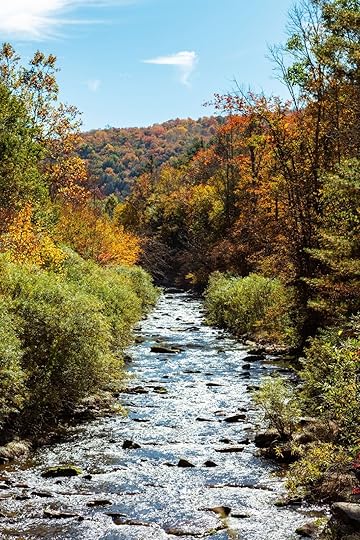
Photo: Urban Cowboy Hotels
The 19th-century 26-key alpine inn is set on 68 acres in the Big Indian Wilderness, two and half hours from New York. What makes Urban Cowboy’s luxury retreat more inviting is that there’s no cell phone service.

Photo: Urban Cowboy Hotels
In collaboration with Sensible Weather, a Santa Monica-based company that provides weather protection options for brands to reimburse customers for weather-related issues, Urban Cowboy Lodge has coined the $24-a-night deal The Election Escape. Ideal for those who want to avoid doom scrolling around the election, after you’ve got your vote in, you can escape to the Catskills from November 1 to November 7.
A cabin stay normally costs $750 per night. Bookings open on a first-come, first-served basis on Thursday, October 3 at noon ET.

Photo: Urban Cowboy Hotels
On arrival, you can check yourself and your phone in (if you wish) and receive a Polaroid camera to snap memories of sauna sessions, foliage hikes, your cowboy-kitsch cabin, and you in your jade green Pendleton robe sipping an Old Fashioned on your private patio.
Sensible Weather are also throwing in a weather guarantee: if it rains for more than two hours during your stay, you’ll be refunded. But let’s hope that’s not the case because you’ll want to enjoy the end of the foliage season, which is best on cool, crisp days. 
September 22, 2024
The 7 Best London Martini Bars, Curated by a Professional Gin Maker

Martinis may not be the top-ordered cocktail around the world (though espresso martinis are quite popular) but they’re certainly some of the best-known. Though the martini’s roots likely trace back to California, some of the best iterations are found across the pond – specifically, in London, where craft cocktail culture has thrived for over a century.
Thanks to a slew of talented mixologists and equally as many classy establishments around the city, seeking out a solid martini in The Big Smoke is hardly a daunting feat. But as is always the case when searching for the best, knowing where to go is key. And who better to ask than a local gin expert? I enlisted the help of Simon Ford, founder of Fords Gin, to offer guidance on the best martinis in London. Get your glasses (and Google Maps pins) ready.
Dukes Bar at the Dukes HotelView this post on Instagram
A post shared by DUKES Bar (@dukesbarlondon)
For one of the best martinis in all of London, look no further than Dukes Bar, a personal and sentimental favorite of Ford’s. “The Dukes Bar is the first place I ever visited that had tableside martini service,” he reveals. The sultry bar in London’s St. James neighborhood offers a solid dose of reprieve from the city’s bustling streets in one of its busiest neighborhoods. Ford says he was first introduced to the bar’s signature martini by the joint’s head bartender, Alessandro Palazzi, back in the late 1990s. Decades later, Palazzi is still shaking up classic cocktails behind the bar today.
Ford gives the disclaimer that the martinis at Dukes Bar are strong — and he means strong. “The gin or vodka is served straight from the freezer, and therefore requires no dilution from ice,” he reveals. At Dukes Bar, a spritz of vermouth, rather than a standard part, is sprayed into the cocktail glass to accompany the gin. “My favorite part of the service is the garnish. The oils from a large, thin slice of Sicilian lemon are expressed over the martini in front of you and olives are served on the side,” says Ford, who describes the drink as “pure perfection.”
Fun fact: Dukes Bar is also credited as the birthplace of the original Vesper Martini, famously ordered by James Bond in Casino Royale.
Dukes Bar: 35 St James’s Pl, London SW1A 1NY, United Kingdom
Satan’s Whiskers
Photo: Satan’s Whiskers / StevenJoycePhoto
In the Bethnal Green neighborhood of London, Satan’s Whiskers has more of a casual, local vibe than the upscale service at Dukes. But rest assured, the martinis are just as excellent. “Because of the relaxed nature of the bar and its well-executed classic drinks, Satan’s Whiskers is a bartenders’ favorite,” says Ford. He says the bartenders are experts at executing classic cocktails, and you can always count on extremely friendly service. Among London martini bars, it’s known for finding the balance between a classic speakeasy and a cozy British pub.
“The bar team has mastered most of the classic cocktails, especially the martini,” says Ford. And he describes the bar’s owner, Kevin Armstrong, as one of the nicest people in the industry. “After opening some of the world’s best bars for other people, he opened his own place. And after over a decade in business, it just keeps getting more and more popular,” he adds.
Satan’s Whiskers: 343 Cambridge Heath Rd, London E2 9RA, United Kingdom
The American Bar at the SavoyView this post on Instagram
A post shared by @thesavoylondon
With a history going back to 1893, it’s no surprise that The American Bar at the Savoy has long been one of the most highly regarded cocktail bars in the world. The Savoy is where Ada Coleman created the famous “Hanky Panky” cocktail and where Harry Craddock penned his world-famous Savoy Cocktail Book, solidifying it as a must-stop locale not just for fans of London martini bars, but for any lover of classic cocktails. Oh, and it also happens to be the oldest cocktail bar in London.
“The American Bar does an incredible job of honoring the vibe and atmosphere of the golden age of cocktails, making it an iconic place to sample the martini, which is one of the oldest classic cocktails,” says Ford.
Ford shared that he used to run a wine and spirits shop across the street from the Savoy, and that the hotel’s bar team would regularly come in for specialty products. “One day, their head bartender at the time, Peter Dorelli, invited me across to try the cocktail menu. This would be my first introduction into cocktail culture. I started at the top,” he happily remembered.
The American Bar is one of the many cocktail bars in London this writer has visited, and like Ford, I have happy memories. I appreciated not just the unmatched hospitality offered by the bar team, but also the bar’s unforgettable ambiance. Ford explains why that is, with numerous thoughtful restorations over the years, but always with a focus on keeping the bar’s interior feeling like “jumping into a time machine to an age long gone, where the soundtrack is the clinking of martini glasses and live piano.”
The American Bar: 16-18 St James’s Pl, London SW1A 1NJ, United Kingdom
The Spy Bar at Raffles Hotel
Photo: The Spy Bar
As the name implies, “The Spy Bar” is known as one of the best London martini bars, as well as one of the best-kept secrets among cocktail aficionados. And for history buffs, a visit is simply unmissable. “There is something alluring about being able to sip a martini in a room [in which] it’s highly likely that the likes of Winston Churchill and Ian Fleming would have spent time concocting some of their most covert operations for World War II,” Ford says, highlighting the mysterious nature behind this covert hotel bar.
The Spy Bar is inside one of the oldest war offices in London, housed in a small, private room at the newly renovated Raffles Hotel. The formerly secret room was once used for storing classified military intelligence. Now, it’s drinks that promise to leave a lasting impression, not information. “Many notable martini drinkers’ presence would have graced this room, and now you can actually go in and order a great cocktail from their menu, Ford says. “Or you can opt for sipping an ice-cold martini, like I usually do.”
In the spirit of keeping the bar’s reputation for secrecy going, the bar enforces a strict no-photos policy.
The Spy Bar: 57 Whitehall, London SW1A 2BX, United Kingdom
Three SheetsView this post on Instagram
A post shared by Three Sheets (@threesheetsbars)
Soho is undoubtedly one of London’s busiest neighborhoods, but Three Sheets manages to offer a quiet escape. Owned by brothers Noel and Max Venning, this quaint cocktail bar has indoor space plus a relaxing outdoor seating area to enjoy classic cocktails in the sun. In the bar’s interpretation of a dirty martini, Three Sheets uses Belvedere vodka, Koseret tea, olive oil, Picpoul (a French white wine), and sea salt. Three Sheets is the duo’s second bar in London; the first is in East London’s Dalston neighborhood.
“Both of their places are cracking little cocktail bars where classic cocktails and innovative drinks cohabitate perfectly on the menu,” explains Ford, “and it’s also a place where if you ask for a martini, you will get one that is perfectly made.”
Three Sheets: 510b Kingsland Rd, London E8 4AB, United Kingdom
The Connaught Bar at the Connaught Hotel
Photo: The Connaught Bar
It’s impossible to talk about London martini bars without mentioning The Connaught Bar: It garnered the coveted top spot on the World’s 50 Best Bars list from the “World’s 50 Best Restaurants” in both 2020 and 2021. Ford states that the bar has been at the forefront of cocktail culture and hospitality for the past 15 years, elevated mostly in part to the spot’s two resident bartenders, Ago Peronne and Giorgio Bargiani. Both have, perhaps unsurprisingly, won coveted awards (including “World’s Best Bartender”) in annual awards from the “Tales of the Cocktail Foundation.”
“Peronne and Bargiani are known for their theatrical martini service, as well as their ability to bring contemporary cocktails to a classic five-star hotel audience,” Ford says. The bar’s martinis include the customer’s choice from a selection of curated bitters, as well as a show-stopping presentation.
For those looking to take a break from martini sipping, Ford recommends indulging in the bar’s Bloody Mary. It’s been a constant on the bar’s list since it opened in 2008.
Thee Connaught Bar: The Connaught, Connaught, 16 Carlos Pl, London W1K 2AL, United Kingdom
Fords Experimental Cocktail Bar
Photo: Fords Distillers
Bartenders and mixologists, you’re in luck. As of early September 2024, Fords’ new cocktail bar is open, designed with the global cocktail community in mind. The bar is inside the Thames Distillers location in Bermondsey, and was created, Ford says, to be a place that celebrates cocktail culture and hospitality. According to the brand, it “was purpose-built to host bar trade from near and far.”
The space was designed by renowned bar designer Leo Robitschek and local architect Zoe Masterson-Smith, and inspired by the many great London martini bars beloved by cocktail fans. The decor is described in the bar’s press release as “contemporary apothecary meets mid-century,” with a vintage and warm interior. Expect oak-hued wood accents, metallic details, and rich green accents. The small space has a central bar, plus a few plush sofas for lounging.
“To finally have an interactive home for Fords Gin is an enormous milestone,” he says, “and is something I dreamed of from the very beginning,” says Ford.
Thames Distillers: 12 Ossory Rd, London SE1 5AN, United Kingdom 
The 7 Best London Martini Bars, Curated by a Professional Distiller

Martinis may not be the top-ordered cocktail around the world (though espresso martinis are quite popular) but they’re certainly some of the best-known. Though the martini’s roots likely trace back to California, some of the best iterations are found across the pond – specifically, in London, where craft cocktail culture has thrived for over a century.
Thanks to a slew of talented mixologists and equally as many classy establishments around the city, seeking out a solid martini in The Big Smoke is hardly a daunting feat. But as is always the case when searching for the best, knowing where to go is key. And who better to ask than a local gin distiller? I enlisted the help of Simon Ford, founder of Fords Gin, to offer guidance on the best martinis in London. Get your glasses (and Google Maps pins) ready.
Dukes Bar at the Dukes HotelView this post on Instagram
A post shared by DUKES Bar (@dukesbarlondon)
For one of the best martinis in all of London, look no further than Dukes Bar, a personal and sentimental favorite of Ford’s. “The Dukes Bar is the first place I ever visited that had tableside martini service,” he reveals. The sultry bar in London’s St. James neighborhood offers a solid dose of reprieve from the city’s bustling streets in one of its busiest neighborhoods. Ford says he was first introduced to the bar’s signature martini by the joint’s head bartender, Alessandro Palazzi, back in the late 1990s. Decades later, Palazzi is still shaking up classic cocktails behind the bar today.
Ford gives the disclaimer that the martinis at Dukes Bar are strong — and he means strong. “The gin or vodka is served straight from the freezer, and therefore requires no dilution from ice,” he reveals. At Dukes Bar, a spritz of vermouth, rather than a standard part, is sprayed into the cocktail glass to accompany the gin. “My favorite part of the service is the garnish. The oils from a large, thin slice of Sicilian lemon are expressed over the martini in front of you and olives are served on the side,” says Ford, who describes the drink as “pure perfection.”
Fun fact: Dukes Bar is also credited as the birthplace of the original Vesper Martini, famously ordered by James Bond in Casino Royale.
Dukes Bar: 35 St James’s Pl, London SW1A 1NY, United Kingdom
Satan’s Whiskers
Photo: Satan’s Whiskers / StevenJoycePhoto
In the Bethnal Green neighborhood of London, Satan’s Whiskers has more of a casual, local vibe than the upscale service at Dukes. But rest assured, the martinis are just as excellent. “Because of the relaxed nature of the bar and its well-executed classic drinks, Satan’s Whiskers is a bartenders’ favorite,” says Ford. He says the bartenders are experts at executing classic cocktails, and you can always count on extremely friendly service. Among London martini bars, it’s known for finding the balance between a classic speakeasy and a cozy British pub.
“The bar team has mastered most of the classic cocktails, especially the martini,” says Ford. And he describes the bar’s owner, Kevin Armstrong, as one of the nicest people in the industry. “After opening some of the world’s best bars for other people, he opened his own place. And after over a decade in business, it just keeps getting more and more popular,” he adds.
Satan’s Whiskers: 343 Cambridge Heath Rd, London E2 9RA, United Kingdom
The American Bar at the SavoyView this post on Instagram
A post shared by @thesavoylondon
With a history going back to 1893, it’s no surprise that The American Bar at the Savoy has long been one of the most highly regarded cocktail bars in the world. The Savoy is where Ada Coleman created the famous “Hanky Panky” cocktail and where Harry Craddock penned his world-famous Savoy Cocktail Book, solidifying it as a must-stop locale not just for fans of London martini bars, but for any lover of classic cocktails. Oh, and it also happens to be the oldest cocktail bar in London.
“The American Bar does an incredible job of honoring the vibe and atmosphere of the golden age of cocktails, making it an iconic place to sample the martini, which is one of the oldest classic cocktails,” says Ford.
Ford shared that he used to run a wine and spirits shop across the street from the Savoy, and that the hotel’s bar team would regularly come in for specialty products. “One day, their head bartender at the time, Peter Dorelli, invited me across to try the cocktail menu. This would be my first introduction into cocktail culture. I started at the top,” he happily remembered.
The American Bar is one of the many cocktail bars in London this writer has visited, and like Ford, I have happy memories. I appreciated not just the unmatched hospitality offered by the bar team, but also the bar’s unforgettable ambiance. Ford explains why that is, with numerous thoughtful restorations over the years, but always with a focus on keeping the bar’s interior feeling like “jumping into a time machine to an age long gone, where the soundtrack is the clinking of martini glasses and live piano.”
The American Bar: 16-18 St James’s Pl, London SW1A 1NJ, United Kingdom
The Spy Bar at Raffles Hotel
Photo: The Spy Bar
As the name implies, “The Spy Bar” is known as one of the best London martini bars, as well as one of the best-kept secrets among cocktail aficionados. And for history buffs, a visit is simply unmissable. “There is something alluring about being able to sip a martini in a room [in which] it’s highly likely that the likes of Winston Churchill and Ian Fleming would have spent time concocting some of their most covert operations for World War II,” Ford says, highlighting the mysterious nature behind this covert hotel bar.
The Spy Bar is inside one of the oldest war offices in London, housed in a small, private room at the newly renovated Raffles Hotel. The formerly secret room was once used for storing classified military intelligence. Now, it’s drinks that promise to leave a lasting impression, not information. “Many notable martini drinkers’ presence would have graced this room, and now you can actually go in and order a great cocktail from their menu, Ford says. “Or you can opt for sipping an ice-cold martini, like I usually do.”
In the spirit of keeping the bar’s reputation for secrecy going, the bar enforces a strict no-photos policy.
The Spy Bar: 57 Whitehall, London SW1A 2BX, United Kingdom
Three SheetsView this post on Instagram
A post shared by Three Sheets (@threesheetsbars)
Soho is undoubtedly one of London’s busiest neighborhoods, but Three Sheets manages to offer a quiet escape. Owned by brothers Noel and Max Venning, this quaint cocktail bar has indoor space plus a relaxing outdoor seating area to enjoy classic cocktails in the sun. In the bar’s interpretation of a dirty martini, Three Sheets uses Belvedere vodka, Koseret tea, olive oil, Picpoul (a French white wine), and sea salt. Three Sheets is the duo’s second bar in London; the first is in East London’s Dalston neighborhood.
“Both of their places are cracking little cocktail bars where classic cocktails and innovative drinks cohabitate perfectly on the menu,” explains Ford, “and it’s also a place where if you ask for a martini, you will get one that is perfectly made.”
Three Sheets: 510b Kingsland Rd, London E8 4AB, United Kingdom
The Connaught Bar at the Connaught Hotel
Photo: The Connaught Bar
It’s impossible to talk about London martini bars without mentioning The Connaught Bar: It garnered the coveted top spot on the World’s 50 Best Bars list from the “World’s 50 Best Restaurants” in both 2020 and 2021. Ford states that the bar has been at the forefront of cocktail culture and hospitality for the past 15 years, elevated mostly in part to the spot’s two resident bartenders, Ago Peronne and Giorgio Bargiani. Both have, perhaps unsurprisingly, won coveted awards (including “World’s Best Bartender”) in annual awards from the “Tales of the Cocktail Foundation.”
“Peronne and Bargiani are known for their theatrical martini service, as well as their ability to bring contemporary cocktails to a classic five-star hotel audience,” Ford says. The bar’s martinis include the customer’s choice from a selection of curated bitters, as well as a show-stopping presentation.
For those looking to take a break from martini sipping, Ford recommends indulging in the bar’s Bloody Mary. It’s been a constant on the bar’s list since it opened in 2008.
Thee Connaught Bar: The Connaught, Connaught, 16 Carlos Pl, London W1K 2AL, United Kingdom
Fords Experimental Cocktail Bar
Photo: Fords Distillers
Bartenders and mixologists, you’re in luck. As of early September 2024, Fords’ new cocktail bar is open, designed with the global cocktail community in mind. The bar is inside the Thames Distillers location in Bermondsey, and was created, Ford says, to be a place that celebrates cocktail culture and hospitality. According to the brand, it “was purpose-built to host bar trade from near and far.”
The space was designed by renowned bar designer Leo Robitschek and local architect Zoe Masterson-Smith, and inspired by the many great London martini bars beloved by cocktail fans. The decor is described in the bar’s press release as “contemporary apothecary meets mid-century,” with a vintage and warm interior. Expect oak-hued wood accents, metallic details, and rich green accents. The small space has a central bar, plus a few plush sofas for lounging.
“To finally have an interactive home for Fords Gin is an enormous milestone,” he says, “and is something I dreamed of from the very beginning,” says Ford.
Thames Distillers: 12 Ossory Rd, London SE1 5AN, United Kingdom 
19 Dreamy Airbnbs in Hawai’i That Are Right on the Beach
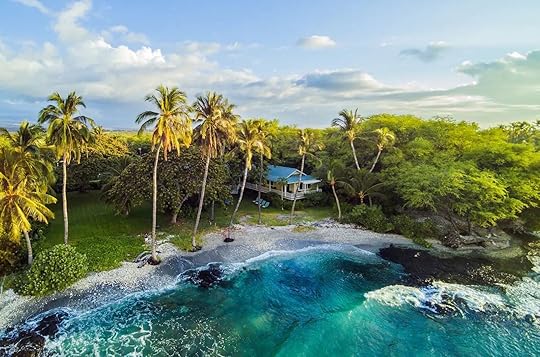
You don’t plan a trip to Hawai’i for the state’s juicy pineapples or the beautiful flowers leis. You plan a trip to Hawai’i to enjoy the archipelago’s sunshine and gorgeous beaches. Therefore, the best way to make the most of your vacation is not to book a hotel with a pool, but to find a Hawai’i Airbnb on the beach so you can sink your toes in the hot sand and go for a salty swim whenever the fancy takes you.
Hawai’i Airbnbs on the beach on the Big IslandHawai’i Airbnbs on the beach on OʻahuHawai’i Airbnbs on the beach on MauiHawai’i Airbnbs on the beach on KauaʻiTraveling to Hawaiʻi? Check out Matador’s guides to the best places to stay on every island:These Are the Best Hotels in Waikiki, Minutes From the Sand, for All BudgetsExperience the Best of Honolulu at These Luxury Resort HotelsThe coolest Airbnbs on O’ahuThe best Airbnbs on Hawai’i’s Big Island13 stunning yet affordable Airbnbs on Kaua’iThese Hotels on Hawai’i’s Big Island Showcase the State’s Best Beaches
We hope you love the Aibnbs we recommend in Hawai’i! Just so you know, Matador may collect a small commission from the links on this page if you decide to book a stay. Listed prices are accurate as of the time of publication.
Hawai’i Airbnbs on the beach on the Big IslandLuxury oceanfront condo at Hapuna Beach Resort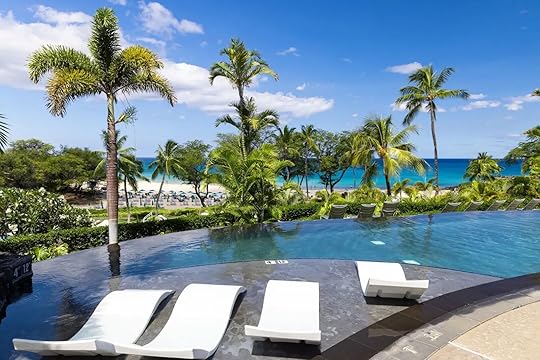 Photo: Airbnb
Photo: Airbnb Photo: Airbnb
Photo: Airbnb Photo: AirbnbSee more photos
Photo: AirbnbSee more photosThis luxury two-bedroom, two-bathroom condo is among the top 10 percent of homes on Airbnb for five-star reviews and host service. It is located within the Hapuna Beach Resort on the Kohala Coast. For an extra fee, guests can use resort facilities — pools, bars, restaurants, and watersports. An interior designer decorated the condo, so expect five-star furnishings of a high-end hotel with the flexibility and homely feel of an Airbnb.
Four guests, two bedrooms
Price: $950 per night
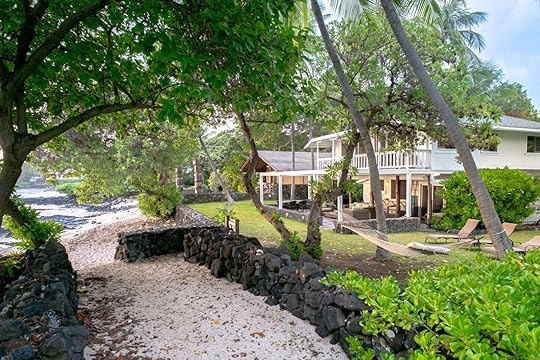 Photo: Airbnb
Photo: Airbnb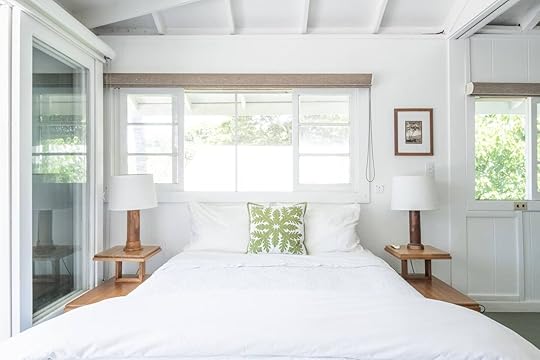 Photo: Airbnb
Photo: Airbnb Photo: AirbnbSee more photos
Photo: AirbnbSee more photosPerfect for a small family or couple, this comfortable three-bedroom cottage, The Seaside Zen Cottage, is around two miles south of Kailua-Kona. It fronts a secluded sandy beach with a sheltered lagoon, and there’s a lawned area and hammock for afternoon naps. You’ll wake to the sound of the ocean, enjoy breakfast on the large lanai, and look out over green sea turtles swimming in the water. The interior is light and airy with calming green accents, perfectly complimenting the natural surroundings.
Six guests, three bedrooms
Price: $985 per night
 Photo: Airbnb
Photo: Airbnb Photo: Airbnb
Photo: Airbnb Photo: AirbnbSee more photos
Photo: AirbnbSee more photosOn the shores of beautiful Puako Bay, this beautiful property will make your vacation dreams come true. The only thing standing between this magnificent house and the turquoise waters of the Pacific Ocean are a row of palm trees and a manicured lawn dotted with loungers and a hammock. Inside the house, the decor is elegant and classic, with muted colors and high-quality furniture. The property consists of a three-bedroom and three-bathroom house attached to an independent annex that has one bedroom and one bathroom. This Hawai’i Airbnb on the beach comes with snorkel gear, backpack beach chairs, umbrellas, boogie boards, and coolers.
Eight guests, four bedrooms
Price: $2,048 per night
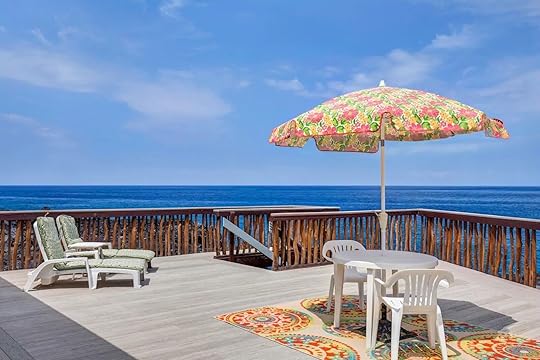 Photo: Airbnb
Photo: Airbnb Photo: Airbnb
Photo: Airbnb Photo: AirbnbSee more photos
Photo: AirbnbSee more photosThis secluded, oceanfront property is located on an ancient lava flow on the South Kona coast in Milolii, and is only 30 miles south of Kailua-Kona and an hour’s drive from Volcano National Park. From the 1000 square foot sundeck, you’ll enjoy panoramic views of the ocean and its inhabitants (whales, dolphins, and turtles), as well as Hawai’i’s stunning sunsets. Inside, the decor is simple, colorful, and perfectly in tune with the tropical vacation theme. There is a fully equipped kitchen so you can cook your own meals and stay in your peaceful bubble for the entirety of your trip.
Four guests, two bedrooms
Price: $390 per night
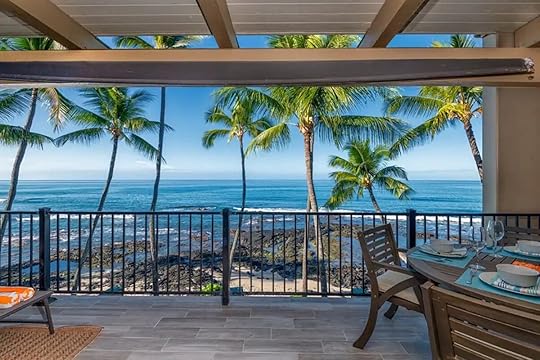 Photo: Airbnb
Photo: Airbnb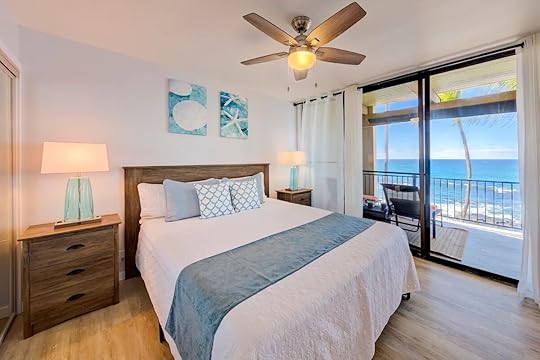 Photo: Airbnb
Photo: Airbnb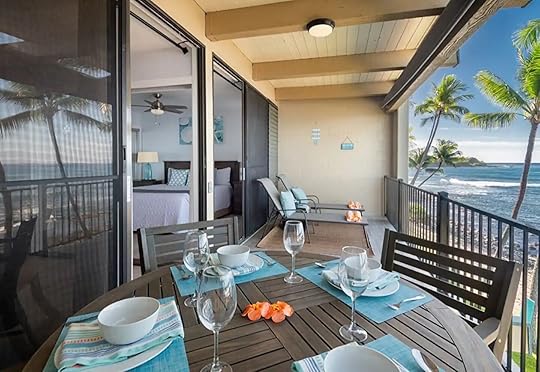 Photo: AirbnbSee more photos
Photo: AirbnbSee more photosLocated on Kona’s main strip, this recently renovated condo has ocean views from its large deck, as well as from the dining and lounging areas, the master bedroom, the living room, and the guest bedroom. Sit on the patio furniture on the deck and enjoy the sight of the palm trees swaying in the wind. Look out for marine creatures like sea turtles, whales, and dolphins — you have a front-row seat to see their comings and goings. This property comes with beach gear, boogie boards, cooler, yoga mats, etc.
Six guests, two bedrooms
Price: $299 per night
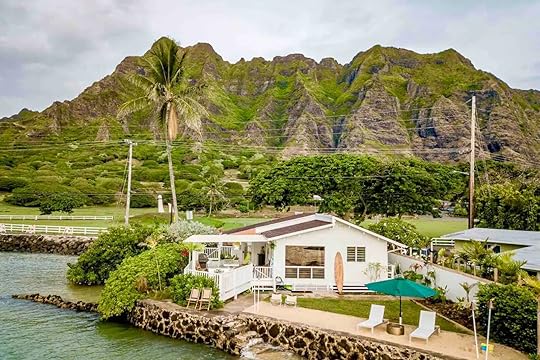 Photo: Airbnb
Photo: Airbnb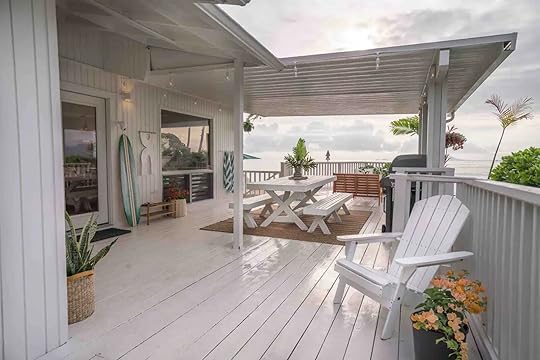 Photo: Airbnb
Photo: Airbnb Photo: AirbnbSee more photos
Photo: AirbnbSee more photosThe Chinamans Ocean Front Beach House, a luxurious beach Airbnb between the Kualoa Ranch and the Pacific Ocean, offers an unforgettable stay. Recently renovated in 2020, this stunning property has breathtaking ocean views and a secluded location that provides unmatched tranquility on Oʻahu. The aptly named home also looks out to The Chinaman’s Hat (also known as Mokoli’i), a small, uninhabited volcanic island located off the coast of Kualoa Point, which you can reach by kayak, paddleboard, or even walking during low tide. The Airbnb has been set up to accommodate one or even two families with three bedrooms and lots of indoor and outdoor seating.
Eight guests, three bedrooms
Price: $450 per night
 Photo: Airbnb
Photo: Airbnb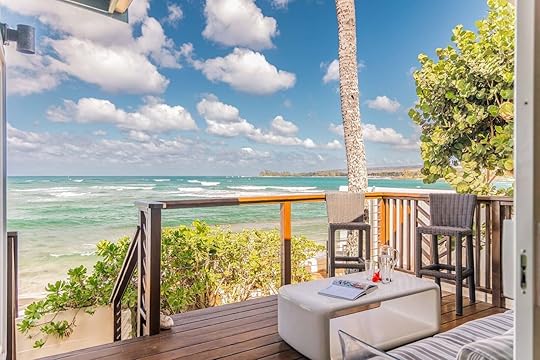 Photo: Airbnb
Photo: Airbnb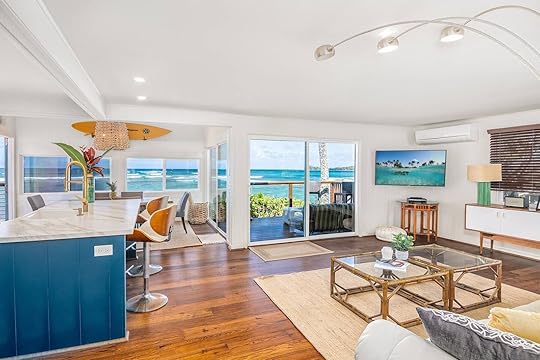 Photo: AirbnbSee more photos
Photo: AirbnbSee more photosThis duplex home is on a beautiful white sandy beach in Haleʻiwa, the social and artistic hub of the North Shore. This area of the Big Island is a far cry from the buzz of Waikīkī, and that’s exactly what the locals and those who choose to stay here want. The Airbnb has an open-planned living room, kitchen, and dining area. Outside, there’s a grill on the lanai with spectacular views over the water. There’s air-conditioning throughout the house, but you might not need it considering the calming ocean breeze that filters through the home.
Four guests, two bedrooms
Price: $740 per night
 Photo: Airbnb
Photo: Airbnb Photo: Airbnb
Photo: Airbnb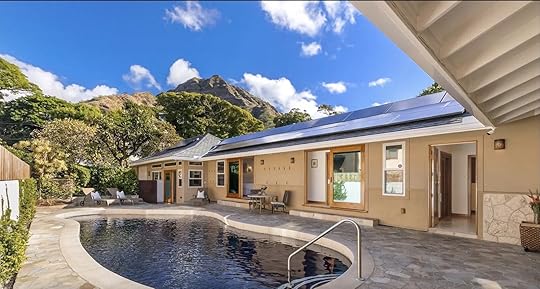 Photo: AirbnbSee more photos
Photo: AirbnbSee more photosThe best part of this oceanfront property is undeniably that it is oceanfront — the views from the open-plan living room and kitchen, as well as from the perfectly landscaped yard, are spectacular. But the wood-panelled vaulted ceiling in main living area is a close second — it adds a unique touch of luxury to the property. All the bedrooms in the house (each with an ensuite bathroom and AC) have also been fitted with this particularly beautiful design element. There is a small pool in the backyard from where guests can admire the Diamond Head Crater, and the beach is a hop and skip away. This property is located three miles away from Waikiki.
Eight guests, three bedrooms
Price: $1883 per night
 Photo: Airbnb
Photo: Airbnb Photo: Airbnb
Photo: Airbnb Photo: AirbnbSee more photos
Photo: AirbnbSee more photosThis cozy and tastefully decorated penthouse condo is steps away from Waikiki Beach and has sweeping views of the ocean from its furnished balcony. While small, the property is light and airy, with a clean and simple decor.
Four guests, one bedroom
Price: $349 per night
 Photo: Airbnb
Photo: Airbnb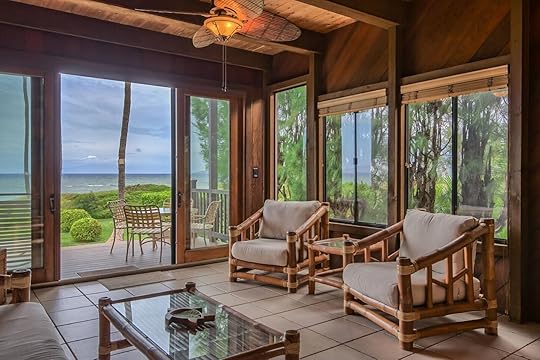 Photo: Airbnb
Photo: Airbnb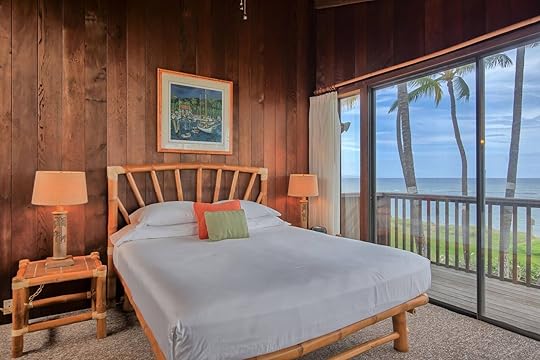 Photo: AirbnbSee more photos
Photo: AirbnbSee more photosThis is a new listing on Airbnb for 2024 and is ideal for those who want more space. Although there are only two bedrooms, the beach house has enough room for a large family. The redwood townhouse was built in 1977 and has recently been remodeled and updated. It’s located in Kihei on the south side of Maui, home to some of the nicest beaches on the island.
Six guests, two bedrooms
Price: $571 per night
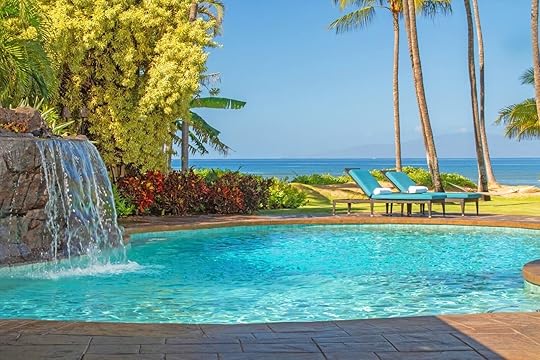 Photo: Airbnb
Photo: Airbnb Photo: Airbnb
Photo: Airbnb Photo: AirbnbSee more photos
Photo: AirbnbSee more photosIf you visit Hawai’i during mango season (July to October), you can help yourself to fruit from the tree outside this beach front estate. Although this is a little more expensive than many other listings, you get much of your money with a stay here. There’s a large heated swimming pool, a newly installed hot tub, a brand new kitchen, a cabana bar hut, and an enormous grass lawn with a panoramic oceanfront view. In front of the rental, the shoreline has a quiet sandy beach area sheltered by an ancient off-shore reef. Guests can use portable coolers, beach chairs, and towels that come with a stay at the stunning property.
Six guests, three bedrooms
Price: $1620 per night
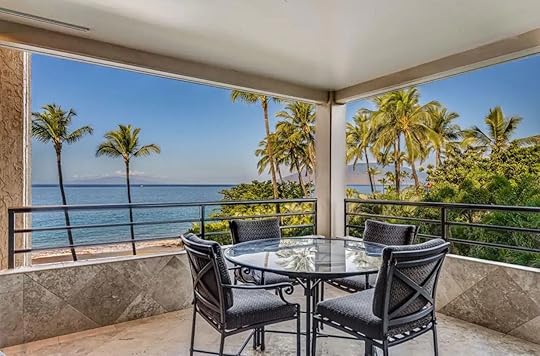 Photo: Airbnb
Photo: Airbnb Photo: Airbnb
Photo: Airbnb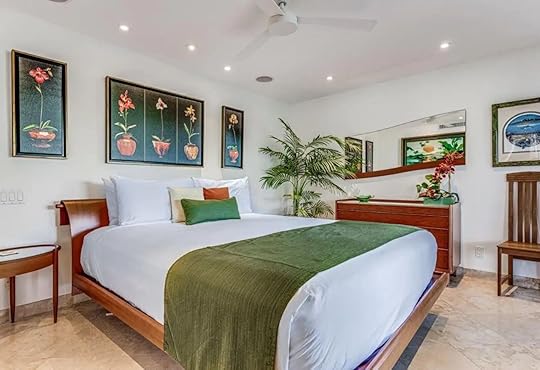 Photo: AirbnbSee more photos
Photo: AirbnbSee more photosThis large, modern, and swanky condo in Wailea-Makena has marble floors, a gleaming kitchen, high-quality furniture, and, more importantly, views of the ocean that will knock your socks off. Located right on the beach, this condo is part of the Polo Beach Club and guests have therefore access to the club’s oceanfront pool, hot tub, barbecue, and herb garden. The best spot in this amazing condo is the large balcony, furnished with patio furniture so you can enjoy every single meal, snack, and cup of coffee facing the beauty of the Pacific Ocean.
Four guests, two bedrooms
Price: $1626 per night
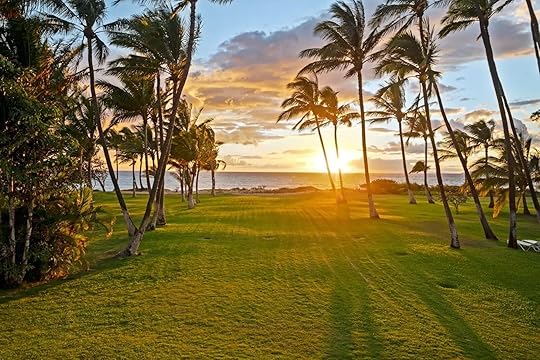 Photo: Airbnb
Photo: Airbnb Photo: Airbnb
Photo: Airbnb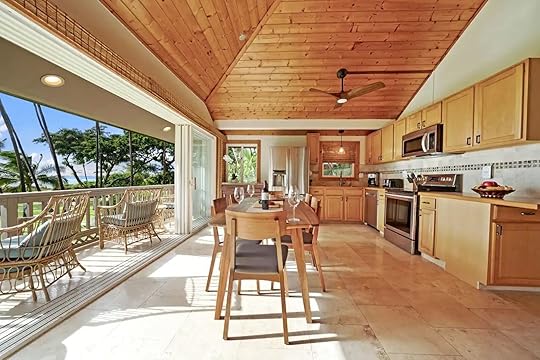 Photo: AirbnbSee more photos
Photo: AirbnbSee more photosThis luxury oceanfront home in Kihei has a beautifully manicured backyard lawn lined with palm trees that leads directly to the beach and the turquoise waters of the ocean. Recently renovated, this property’s decor is contemporary and tasteful — the vaulted ceiling in the living area is a beautiful touch. There is a private hot tub in the backyard that will ensure guests are properly relaxed at all times. The large sundeck facing the backyard and the beach is where you’ll want to spend most of your time.
Six guests, two bedrooms
Price: $1045 per night
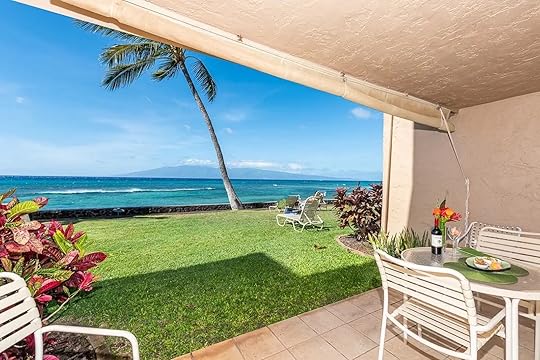 Photo: Airbnb
Photo: Airbnb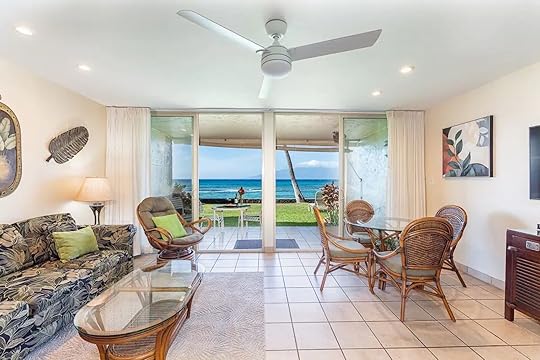 Photo: Airbnb
Photo: Airbnb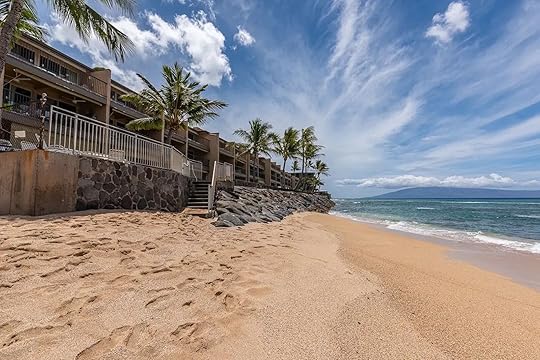 Photo: AirbnbSee more photos
Photo: AirbnbSee more photosLocated in Lahaina this cozy condo is a few steps away from the beach via a short path and a staircase at the end of the yard. The property has a lovely terrace and a backyard dotted with loungers from where you can enjoy views of the ocean and the sunset. There is a recently remodelled and fully equipped kitchen.
Four guests, one bedroom
Price: $220 per night
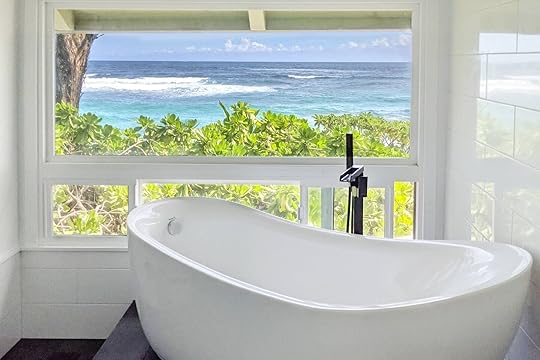 Photo: Airbnb
Photo: Airbnb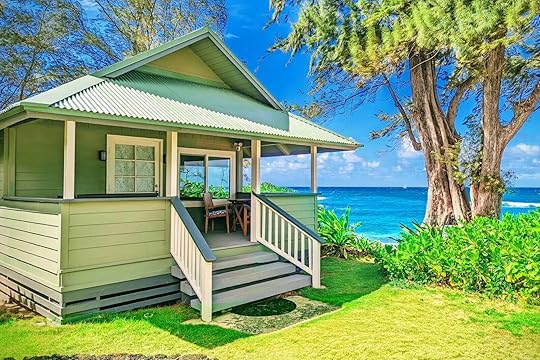 Photo: Airbnb
Photo: Airbnb Photo: AirbnbSee more photos
Photo: AirbnbSee more photosOne to bookmark, this is one of the prettiest Airbnbs I’ve found in Hawai’i. It’s absolutely perfect for a couple or small family. The one-bedroom is in the beautiful town of Hāʻena. If you want to get away from busy beaches, main touristy spots, and crowds, there is where you want to be. The home is a quick bike ride from Tunnels Beach, which has some of Kauai’s best snorkeling and opportunities to swim with sea turtles. The newly renovated cottage has panoramic ocean views from every room — including the bathroom with a tub looking out over the water.
Four guests, one bedrooms
Price: $722 per night
 Photo: Airbnb
Photo: Airbnb Photo: Airbnb
Photo: Airbnb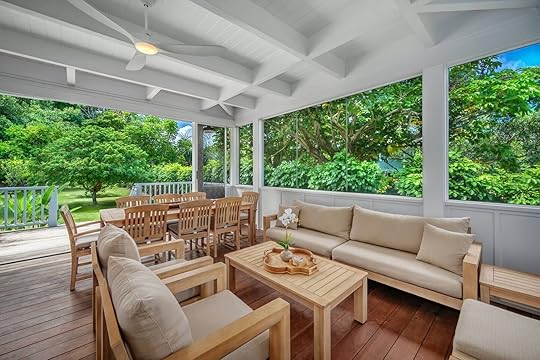 Photo: AirbnbSee more photos
Photo: AirbnbSee more photosSteps to the shoreline at Anini Beach, on the North Shore of Kauai, this beach retreat has three ensuites, a fruit grove, expansive front and back yards, and a path from the front door to the beach. If you’re visiting during whale-watching season, seven miles northwest is Hanalei, where you can join locals on the beach to spot whales breaching. The light-drenched home has a neutral color pallet and an open-planned layout perfect for entertaining.
Six guests, three bedrooms
Price: $825 per night
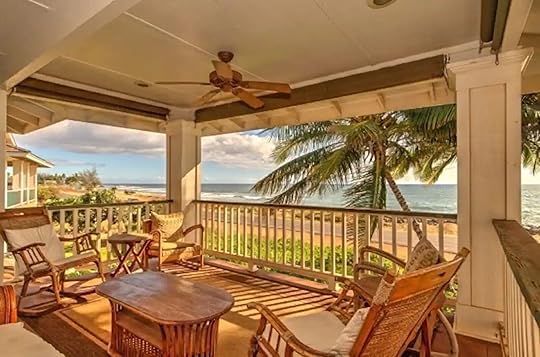 Photo: Airbnb
Photo: Airbnb Photo: Airbnb
Photo: Airbnb Photo: AirbnbSee more photos
Photo: AirbnbSee more photosThis large oceanfront house is the perfect setting for a family gathering. Located in the village of Kekaha, the house sits right across from the beach. Inside, the decor is warm and homely, making guests feel comfortable instantly. The large furnished sundeck is the ideal spot for family dinners or just quiet contemplation. The large kitchen is fully equipped.
Eight guests, four bedrooms
Price: $767 per night
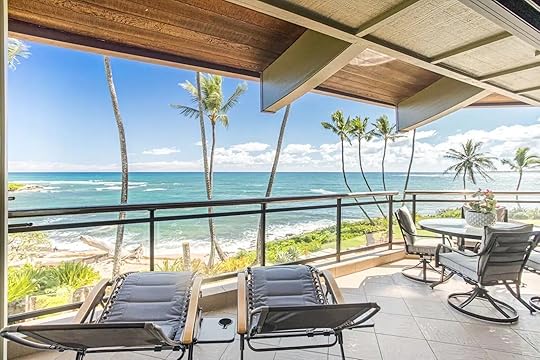 Photo: Airbnb
Photo: Airbnb Photo: Airbnb
Photo: Airbnb Photo: AirbnbSee more photos
Photo: AirbnbSee more photosThis luxury condo in Kapaʻa is just steps away from Lae Nani beach and has extraordinary panoramic views of the ocean from its large sundeck and from the main living area. Inside this recently remodelled property, the decor is contemporary with an open-plan kitchen and living room under a vaulted ceiling, and a modern spiral staircase. Guests can access the building’s amenities, such as the beautiful pool and the outdoor barbecue. Snorkel sets, beach towels, beach chairs, beach umbrellas, and a cooler are provided.
Six guests, two bedrooms
Price: $649 per night
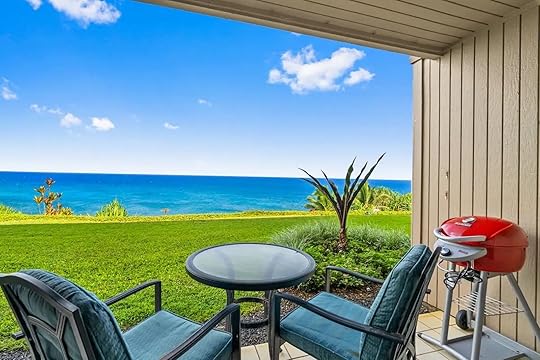 Photo: Airbnb
Photo: Airbnb Photo: Airbnb
Photo: Airbnb Photo: AirbnbSee more photos
Photo: AirbnbSee more photosThis condo may be small, but it packs a punch. The views from every room are either of the strikingly blue ocean or the lush surrounding foliage. The decor is simple, colorful, and homely. This condo is part of Pali Ke Kua resort, so guest can have access to its lovely pool. 
Four guests, one bedroom
Price: $320 per night
September 21, 2024
The 11 Best Airbnbs in New Orleans for a Bachelorette Getaway

Bachelorette parties tend to be big extravagant parties. That’s why New Orleans is the ideal bachelorette party destination: There’s live music, seafood restaurants, drinking is allowed on the street — and of course, you can’t miss out on the rowdy atmosphere of the Bourbon street bars. So make the most of your time you need a New Orleans bachelorette party airbnb that is comfortable and stylish — and a pool doesn’t hurt either.
Usually lots of friends are involved, which can make the planning tedious — even if everyone is looking forward to the trip. You need a big space, with lots of room to lounge and relax (recovering from last night’s hangover is crucial so you can do it all again). Ideally, there will be space in the backyard for drinks, dinner, or just catching some rays in the afternoon before heading out for dinner or hitting the bars. And you probably want a pool too, because it’s not really a vacation if you can’t throw on your bathing suit and go for a dip. The New Orleans bachelorette party airbnb that your group lands on should be a space you look forward to coming back to at the end of the night.
The best New Orleans bachelorette party airbnb will sleep many people and have lots of communal lunge space, and there plenty of options that include several that are close to the French Quarter if you’re looking for easy access to restaurants and nightlife. These highly rated properties offer quirky decorations, spacious backyards for dinner parties and late night drinks, and comfortable bedrooms where you can get the rest you need to party all day with your friends. Here’s where to book your next stay.
We hope you love the spaces and stays we recommend! Just so you know, Matador may collect a small commission from the links on this page if you decide to book a stay. Listed prices are accurate as of the time of publication.
5-bedroom house in the Warehouse District in Downtown Photo: Airbnb
Photo: Airbnb Photo: Airbnb
Photo: Airbnb Photo: AirbnbSee more photos
Photo: AirbnbSee more photosDowntown’s Warehouse District, once a bustling hub of industrial activity, has undergone a remarkable transformation in recent years. Now a vibrant and trendy neighborhood, it offers activities for all — even the pickiest in the group. You can take a guided tour of the First Fridays Art Walk to explore the latest exhibitions and meet local artists, dine out at walkable upscale venues and casual eateries, sample local craft beers at the nearby brewery, or heal up for a night on a rooftop patio with panoramic views of the city. The sprawling home has wood beamed ceilings, red brick walls and so much space: There’s a private pool and courtyard, and secure garage parking.
10 guests, five bedrooms
Price: $1,281 per night
 Photo: Airbnb
Photo: Airbnb Photo: Airbnb
Photo: Airbnb Photo: AirbnbSee more photos
Photo: AirbnbSee more photosThis Guest Favorite Airbnb is suitable for a group coming in without a vehicle, as it’s within walking distance of public transportation. The bus stop at the end of the block will take you on a quick ride to nearby streetcar lines — so there’s no excuse not to whip up a tray of morning Aperol mimosas. The outdoor space and pool will be welcome if you visit in summer and after a day exploring the city. The home was completely reconstructed and expanded in 2023 and features high ceilings and professional decor drenched in natural light.
10 guests, five bedrooms
Price: $360 per night
 Photo: Airbnb
Photo: Airbnb Photo: Airbnb
Photo: Airbnb Photo: AirbnbSee more photos
Photo: AirbnbSee more photosBuilt in the 19th century, this home was completely renovated in 2022. It’s centrally located between the French Quarter and Garden District and five minutes from the famous St.Charles Streetcar. It ticks all the boxes for a bachelorette Airbnb: A year-round heated pool, outdoor kitchen, tropical landscaping — the perfect backdrop for group pictures — and plenty of space for dining and entertaining. There’s a noise cap between 10 PM and 8 AM, but this rental’s regulation is not unique. The city requires Airbnbs of this size and in this area to be equipped with a noise monitoring device. But, let’s be honest, the ruckus party can happen in one of the bars a streetcar ride away.
10 guests, five bedrooms
Price: $462 per night
 Photo: Airbnb
Photo: Airbnb Photo: Airbnb
Photo: Airbnb Photo: AirbnbSee more photos
Photo: AirbnbSee more photosThis Airbnb is within the top one percent of listings in the world. It’s been awarded this status for overall star ratings, recent guest reviews, host communication, cancellation rates, and any quality-related issues reported to Airbnb. The spacious upscale five-bedroom, five-bathroom combines historical features with mod cons. It is located on the famous Canal Street, right on the streetcar line, so getting to the French Quarter and City Park will be a breeze. You can sit on the front porch and watch the streetcars pass, and out back, there’s cornhole and a covered deck with seating. If you’re interested, have a good look through the listing, reviews, and photos because this is a real find.
10 guests, five bedrooms
Price: $456 per night
 Photo: Airbnb
Photo: Airbnb Photo: Airbnb
Photo: Airbnb Photo: AirbnbSee more photos
Photo: AirbnbSee more photosAnother top percent Airbnb, this time within the top 10, this artfully designed new-build is the perfect place for those wanting to chill by the pool and spend time outdoors. The 5-bed has a heated pool, a tropical garden, a grill, and lovely outdoor seating with plenty of room for a large group. The colorful, trendy home is a five-minute ride from some of the best bars, restaurants, and jazz clubs of the French Quarter, and there are cafes and shops within walking distance. The home is decorated with murals by a local artist, Zac Maras.
10 guests, five bedrooms
Price: $672 per night
 Photo: Airbnb
Photo: Airbnb Photo: Airbnb
Photo: Airbnb Photo: AirbnbSee more photos
Photo: AirbnbSee more photosThis Airbnb is wild. The opulent villa looks like it’s been styled for a glossy magazine shoot. Built in the mid-1800s, the two-story home has six bedrooms and six and a half bathrooms and was fully renovated in 2024. Original features such as lofty ceilings, wood floors, and historic windows have been restored. The decor is immaculate — and please take time to look through all the photos. There’s also a wrap-around balcony and a private courtyard with a heated swimming pool.
10 guests, six bedrooms
Price: $959 per night
 Photo: Airbnb
Photo: Airbnb Photo: Airbnb
Photo: Airbnb Photo: AirbnbSee more photos
Photo: AirbnbSee more photosThere’s so much to love about this elegant home in the French Quarter: Not only is it close to all the action but it has an outdoor dinner table for group meals in the evenings, a spacious, open kitchen, and comfy couches in the living that are perfect for lounging. The pool and hot tub in the backyard offer opportunities to keep the party at home if your group prefers. There’s a cute porch where you can drink your coffee in the morning, and even a soaking tub in one of the bathrooms.
10 guests, five bedrooms
Price: $1,094 per night
 Photo: Airbnb
Photo: Airbnb Photo: Airbnb
Photo: Airbnb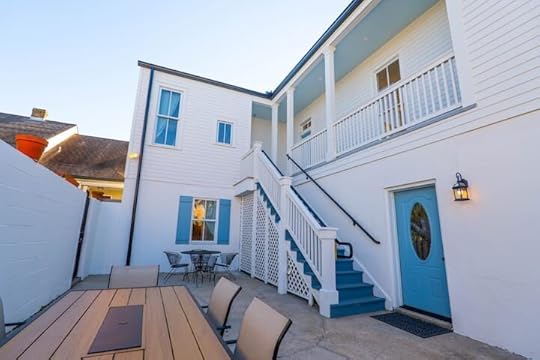 Photo: AirbnbSee more photos
Photo: AirbnbSee more photosWith all white walls and decor, and polished wood floors, this house near Frenchman Street is a stylish option for a bachelorette with a more refined taste. There are live music venues close by and an outdoor patio give guests space to lounge or eat dinner outside.
Eight guests, four bedrooms
Price: $939 per night
 Photo: Airbnb
Photo: Airbnb Photo: Airbnb
Photo: Airbnb Photo: AirbnbSee more photos
Photo: AirbnbSee more photosWith a pool and cozy porch, your bachelorette party might not actually want to leave the backyard. Featuring a colorful mural of the beach, and other colorful details like teal walls and pink velvet chairs in the living room, this home will get you in a playful mood. The huge kitchen has two sinks and two kitchen islands will give everyone space to cook and eat. It’s also within walking distance of two famous New Orleans restaurants, Charlie’s Steakhouse and Pascal’s Manale.
10 guests, five bedrooms
Price: $881 per night
 Photo: Airbnb
Photo: Airbnb Photo: Airbnb
Photo: Airbnb Photo: AirbnbSee more photos
Photo: AirbnbSee more photosWith a cozy porch outfitted with couches and a backyard patio complete with a pool, there’s plenty of space to relax in this townhouse. Hardwood floors and French doors add the home’s elegant interior design. With a kitchen island and a dining room table, guests can enjoy both casual meals and sit down dinners. The Bywater neighborhood is nearby New Orleans favorite Bacchanal restaurant and bar, as well as the French Quarter.
10 guests, five bedrooms
Price: $636 per night
 Photo: Airbnb
Photo: Airbnb Photo: Airbnb
Photo: Airbnb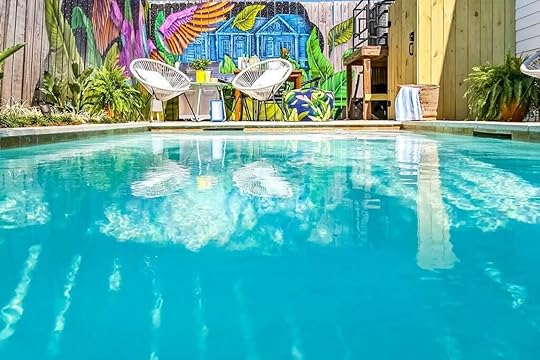 Photo: AirbnbSee more photos
Photo: AirbnbSee more photosWith a colorful mural of plants and parrots on one wall, the outdoor area of this house is where your bachelorette party will want to hang out. The heated pool and grill will get the party started at home before you decide to head out — it’s just a five minute drive to the French Quarter. Multi colored throw pillows, wall art, and another mural inside add to the cheerful design. 
10 guests, five bedrooms
Price: $307 per night
September 20, 2024
California Two Ways: Go Local With Airbnb Experiences in San Francisco and Los Angeles
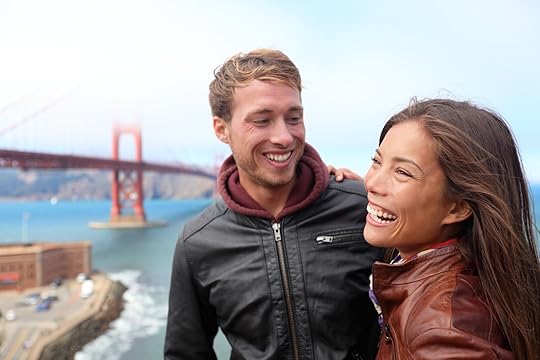
The thrill of exploring new places is as innate to human nature as the joy of savoring a delicious meal. No place better exudes this than California, with its stunning natural beauty, diverse cities and neighborhoods, and vibrant arts and cultural scenes. While the travel industry offers many exciting opportunities, the rise of mass-produced bus tours has sometimes left travelers feeling rushed and disconnected. It’s a shame when a once-in-a-lifetime trip doesn’t fully capture the essence of the destination.
Airbnb Experiences recaptures the authenticity of travel by putting that control in the hands of the two parties where it belongs — you, the traveler, and the locals who know the destination better than anyone. This allows for a curated experience that’s personalized, honest, and — importantly — puts your travel dollar into the local community.
To put this into perspective, let’s say you’re an arts and culture lover planning a trip to two of California’s iconic cultural hubs, San Francisco and Los Angeles. You’ve never been. And while the Golden Gate Bridge and the Hollywood sign are on your list, the trip won’t be complete until you connect with the local art scenes. Uncovering unique “foodie” experiences in each city would be icing on the cake.
There are some things you want to avoid, as well. The idea of shuttling around in a massive tour bus sounds dull. Wandering through galleries without a point of direction? No thanks. Rather, say hello to your new local connections, curated through Airbnb Experiences.
We hope you fall in love with the transformative power of people-led travel experiences! Matador Network partnered with Airbnb to produce this content and may collect a small commission from the links on this page.
California two ways: An art-filled trip begins in San Francisco Photo: Airbnb
Photo: Airbnb Photo: Airbnb
Photo: Airbnb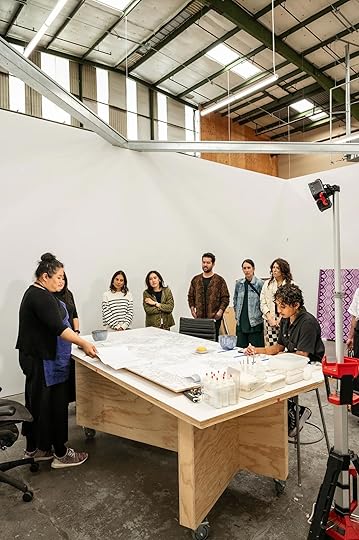 Photo: Airbnb
Photo: Airbnb Photo: Airbnb
Photo: AirbnbSee more photos
The Curated Tour of SF’s Modern Art Scene on Airbnb Experiences connects you with local artists in the vibrant heart of San Francisco’s modern art scene, the Minnesota Street Project. You’ll start the evening with a welcome toast and appetizers in the host’s gallery, where you’ll hear from the artists building the project and making art more accessible to residents and visitors. Then comes the gallery hopping. With local artist Eleanor Harwood, the mastermind behind Eleanor Harwood Gallery and Board President of the San Francisco Art Dealer’s Association as your host, you’ll walk through the district’s galleries to view the works and have the chance to converse with an artist or gallery owner along the way.
Tours offered on Friday and Saturday evenings
From $75 per person
 Photo: Airbnb
Photo: Airbnb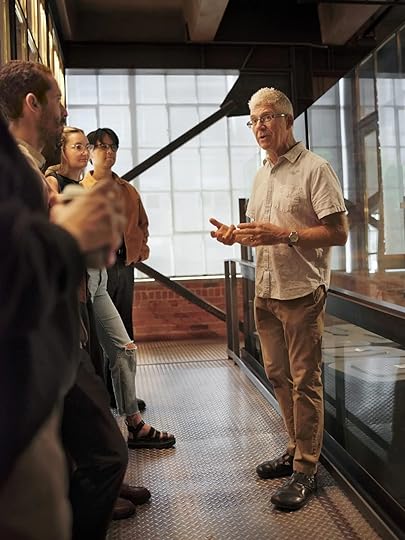 Photo: Airbnb
Photo: Airbnb Photo: Airbnb
Photo: Airbnb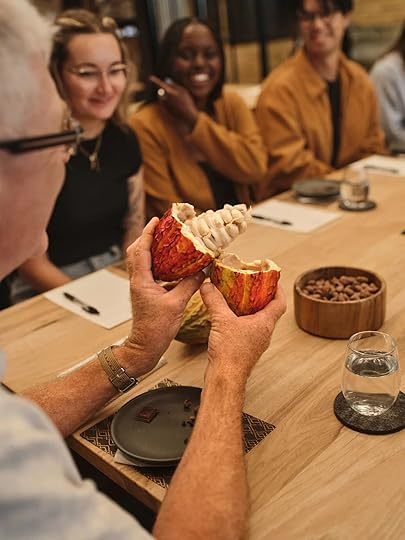 Photo: Airbnb
Photo: AirbnbSee more photosInspired by the artists of the Minnesota Street Project, if you’re up for trying your hand in a California kitchen, a great way to do so in San Francisco is via a private chocolate bar making class, where you’ll learn the ins and outs of the craft at the city’s iconic Dandelion chocolate factory. The experience starts with a tour of the factory. Then, the good stuff — actually making your own Dandelion chocolate bar under the tutelage of professional chocolatier Stephen, the factory’s Director of Chocolate Curriculum (how’s that for a job title?).
Tours offered weekly and by request
From $100 per person
 Photo: Airbnb
Photo: Airbnb Photo: Airbnb
Photo: Airbnb Photo: Airbnb
Photo: Airbnb Photo: Airbnb
Photo: AirbnbSee more photos
After a few engaging days in the City by the Bay, it’s time to head south to the vibrant beaches and street life of Los Angeles. The city is widely known for the culinary offerings of its diverse neighborhoods such as Koreatown, Little Ethiopia, and Chinatown. But LA also has a large West African diaspora and the bold, aromatic spices of this region’s cuisine are increasingly common across the city. There’s no better way to wrap up a long travel day than with a home-cooked West African feast in Hollywood. Chef Tolu Eros welcomes guests into his Hollywood apartment to experience the cuisine of his native Nigeria and the surrounding region via a three-course family-style dinner. Expect a rich feast accented by ginger, cumin, and chili peppers, along with hearty grains like rice, millet, and sorghum. Chef Eros pairs the meal with stories of the cuisine’s origin and its role in shaping food culture around the world.
Experience offered on Thursday nights
Price: From $180 per person
 Photo: Airbnb
Photo: Airbnb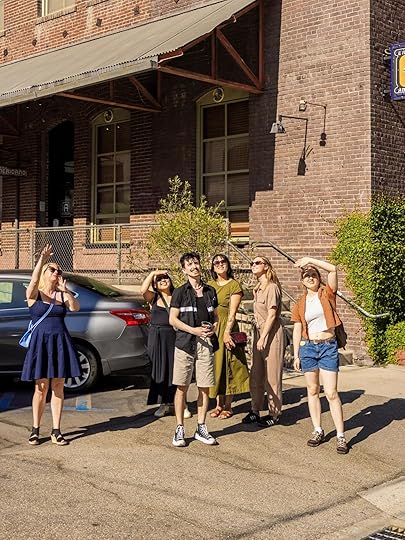 Photo: Airbnb
Photo: Airbnb Photo: Airbnb
Photo: AirbnbSee more photos
The following afternoon it’s time to dive into the art scene of Los Angeles to see how it compares with what you experienced up north. Join local arts and culture journalist Hadley Meares for an exclusive tour of the historic Los Angeles Arts District. Meares guides her guests through galleries big and small, stopping off in Little Tokyo to sample the street eats along the way. The most unique aspect of touring with Hadley is her deep knowledge not only of the city’s art scene but of what actually makes good art — as a writer and tv personality she’s told the stories of artists around the world, and you’ll glean that knowledge as you move through the district. The tour caps with a craft brew from a local brewery.
Tours offered on Friday and Saturday afternoons
From $30 per person
 Photo: Airbnb
Photo: Airbnb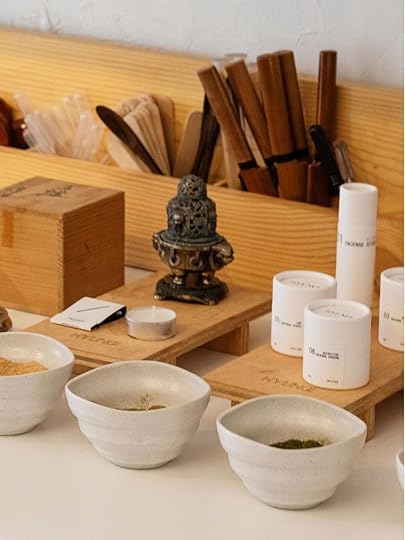 Photo: Airbnb
Photo: Airbnb Photo: Airbnb
Photo: Airbnb Photo: Airbnb
Photo: AirbnbSee more photos
Of course, it wouldn’t be Los Angeles if things didn’t get a little, well, mystifying. Hyungi Park is a Korean-American artist with a unique discipline — crafting natural incense. In her natural incense making course you’ll learn how incense comes together as you craft your own, while learning the history of incense and its practical uses (including as a perfume). You’ll come away with your creation to take home in a pine wood box, the perfect memento to bring home for when you want to recall the trip you took to experience California, two ways.

Tours offered Thursday thru Sunday and by request
From $64 per person
Matador Network's Blog
- Matador Network's profile
- 6 followers



